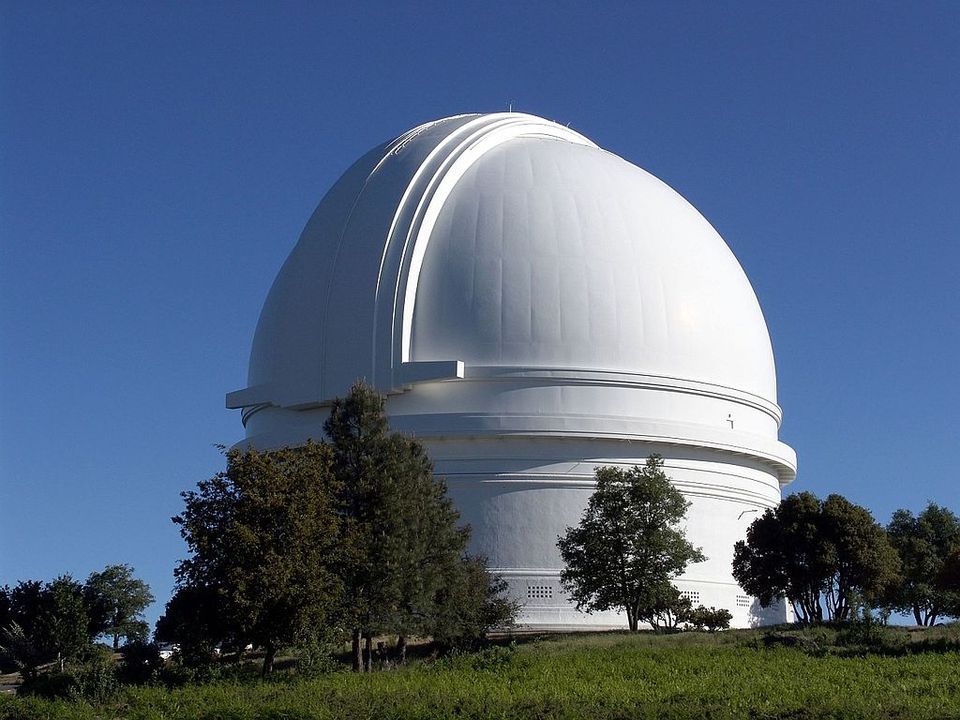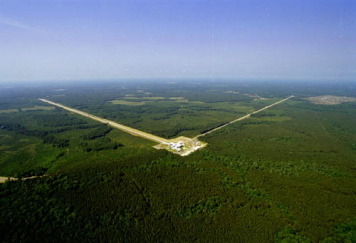What is LIGO?
|
The acronym, LIGO, stands for "Laser Interferometer Gravitational-wave Observatory". Wholly supported by the U.S. National Science Foundation, LIGO is the world's largest gravitational wave observatory and a marvel of precision engineering. Comprising two enormous laser interferometers located 3000 kilometers apart, LIGO exploits the physical properties of light and of space itself to detect and understand the origins of gravitational waves (GW). NSF LIGO (and other detectors like it, e.g., Virgo, GEO, and KAGRA) is not an electromagnetic (EM) observatory and thus bears no resemblance to the kind of place most people probably think of when they hear the word "observatory", for example, the Mount Palomar Observatory telescope dome pictured at right. Instead, each LIGO instrument is configured as a very large L-shaped detector with 4km (2.5 mi) long arms, as shown in the aerial photo of LIGO's Livingston Louisiana detector below right. LIGO is fundamentally different from electromagnetic observatories in three primary ways:
LIGO is blind Unlike optical or radio telescopes, LIGO does not see electromagnetic radiation (e.g., visible light, radio waves, microwaves). But it doesn't have to because gravitational waves are not part of the electromagnetic spectrum. They are a completely different phenomenon altogether (though in some cases, EM astronomers hope to see some form of light coming from GW sources, like that which occurred immediately following the binary neutron star merger detected in August 2017). In fact, electromagnetic radiation is so unimportant to LIGO that its detector components are completely isolated and sheltered from the outside world.
LIGO can't point to specific locations in space Since LIGO doesn’t need to collect light from stars or other objects or regions in space, it doesn't need to be round or dish-shaped like optical telescope mirrors or radio telescope dishes. Nor does it have to be steerable, i.e., able to move around to point in a specific direction. Instead, each LIGO detector consists of two 4km (2.5 mi.) long, 1.2m-wide steel vacuum tubes arranged in an "L" shape (LIGO's laser travels through these arms), and enclosed within a 10-foot wide, 12-foot tall concrete structure that protects the tubes from the environment.
Two instruments are better than one The first confirmed direct detection of gravitational waves was only achieved because the signal was observed by both LIGO detecors (Hanford and Livingston). Since the first detection in 2015 (GW150914), hundreds more signals have been discovered by the twin LIGO interferometers, and some also by Italy's Virgo detector. In some exceptional cases, when a signal has been very strong, a claim of a detection can be made with one instrument. However, this is not the norm, nor ideal. In fact, two or more detectors operating in unison are fundamental to LIGO's ability to contribute to the burgeoning field of gravitational wave astronomy. Most importantly, three or more gravitational wave detectors operating at the same time are required to help electromagnetic astronomers hunt for a potential light signature associated with a gravitational wave. Using triangulation, a process also used to locate a cellphone using three or more cell towers, data from both of LIGO's detectors can be combined with other GW detector data (e.g., Virgo) to greatly narrow down the region of sky that contains the source of the wave. In 10 years of operation, only one source has been localized, illustrating just how incredibly difficult a task this is, even with three detectors (adding data from more detectors will further improve the localization). This event, the first-ever-known binary neutron star merger, GW170817, is arguably LIGO's and Virgo's most important discovery to date, revolutionizing what humans know about the origins of heavy elements in the Universe. Such a discovery could not have occurred wthout both LIGO detectors and Virgo operating simultaneously. The world awaits the next such revolutionary discovery! Though LIGO's mission is to detect gravitational waves from some of the most violent and energetic processes in the Universe, the data LIGO collects may also contribute to other areas of physics such as gravitation, relativity, cosmology, astrophysics, particle physics, and nuclear physics. In this way, LIGO is also a physics experiment on the scale and complexity of some of the world's giant particle accelerators and nuclear physics laboratories. |
||
|
To learn more about interferometers in general and what makes LIGO's interferometers special, visit: |







